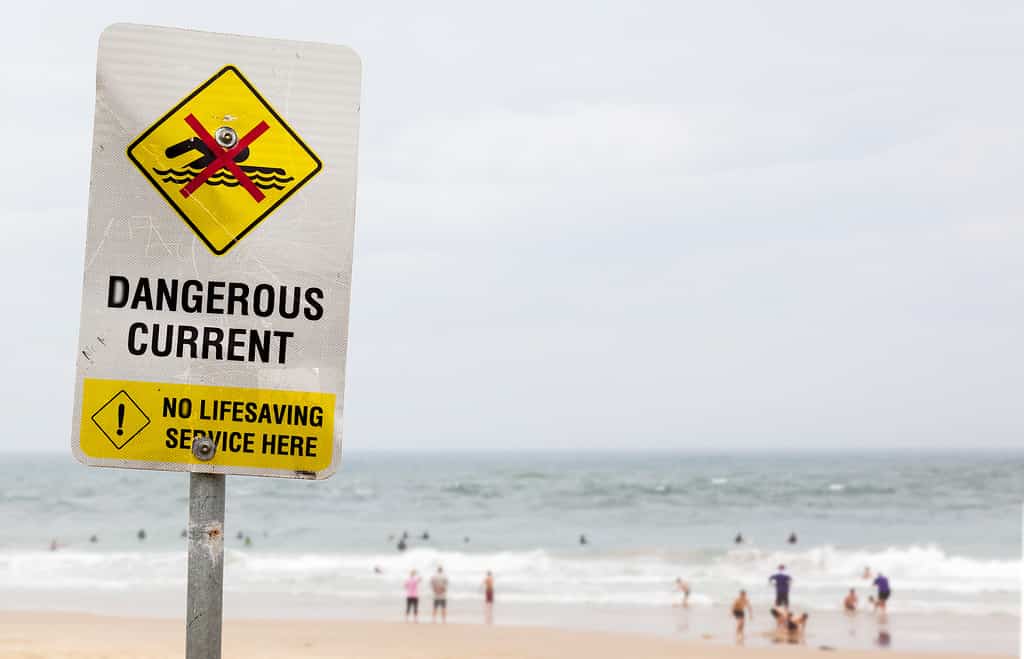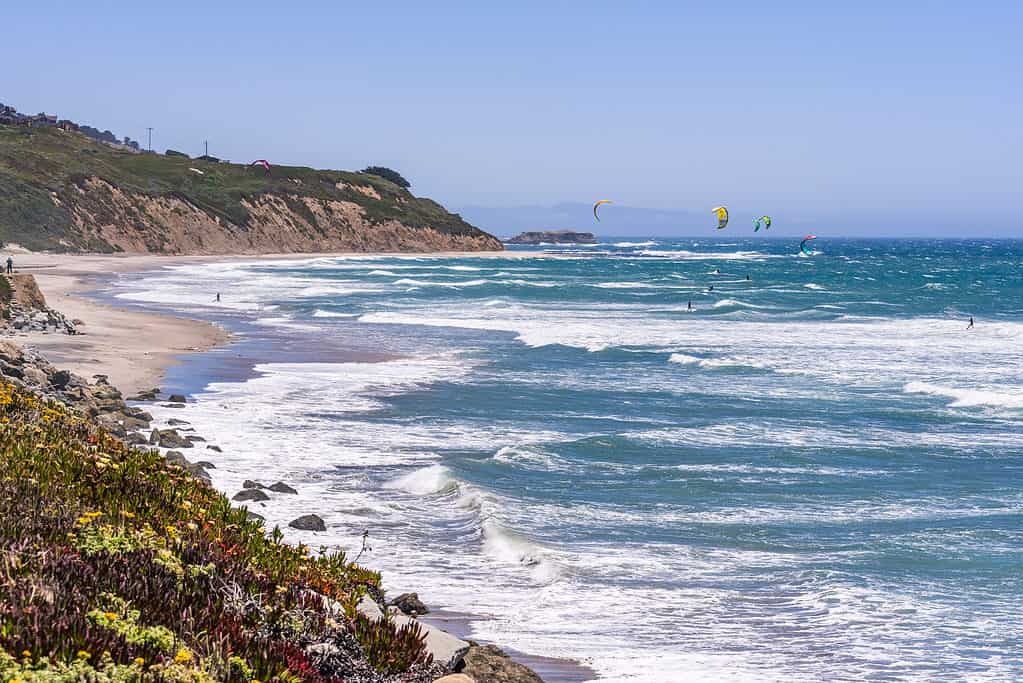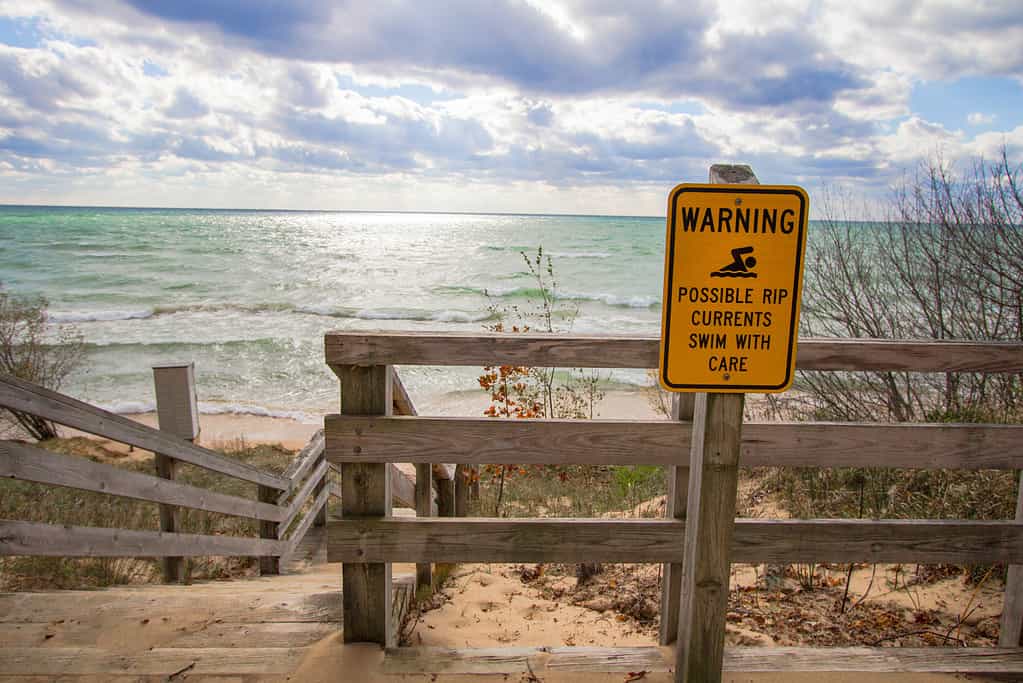Every year, hundreds of people drown due to being trapped in a rip current. Dozens die in the United States alone. But what are rip currents, and why are they so dangerous? Can you safely avoid them while still enjoying a swim in the ocean? What can you do to avoid them or escape them if you are caught in one? How can you spot a rip current and stay safe?
These are all important questions you should answer before you take a trip to the beach. This is especially true if you are going for the first time. Even more important if you are going with small children. Rip currents are deadly if you don’t know what they are or how to escape them. However, if you know what they look like and how to get out, you will be safe.
Don’t underestimate the risks of rip currents! More people die in rip currents than bush fires, tornadoes, and shark attacks combined! But with this guide, not only will you be able to recognize this hidden danger, but you will be able to safely escape it if you are caught in one. Here is how to spot a rip current, and six tips for staying safe.
What is a Rip Current?

Pay attention to signs like these at beaches. They can save your life.
©markrhiggins/iStock via Getty Images
Rip currents can form on beaches of oceans, seas, and even lakes. They are most common on beaches where the slope is gradual and the breaking waves approach parallel to the shore.
Wind and waves will push the water line higher than usual along the shore. All this excess water will return to the ocean or lake in the shortest and easiest way possible. If there are reefs or sandbars further out from the shoreline, the returning water will flow through any breaks in the barrier. The large flow of water through such a small gap creates a rip current.
Water that waves have pushed up onto the shore will flow along the beach toward this rip current. These are called feeder currents. Feeder currents pull floating debris and other things into the main rip current which is very powerful. The rip current continues until it passes through the sandbar or barrier, at which point it dissipates and loses power.
The pull of a rip current is strongest at the surface of the water. Drag and resistance will slow the lower water, making it less powerful.
One of the most dangerous things about rip currents is that the surface of the water may sometimes look calm and smooth. There might not be any breaking waves at all where the rip current is. This calm water is actually a strong rip current flowing swiftly back to sea. Many swimmers think this calm area is a great place to swim, and they end up trapped in the rip current.
Why Are Rip Currents so Dangerous?

You can recognize the rip current in this image by the discolored water flowing out to sea.
©SDBEST/iStock via Getty Images
Of all the rescues lifeguards perform on beaches, over 80% of them are because of rip currents. Rip tides will always have some amount of strong flow back into open water. The strongest currents can flow as fast as 2.5 meters (8.5 feet) per second. That is much faster than any human can swim.
Most people die in rip currents due to drowning from exhaustion. When swimmers realize they are being pulled, rather quickly, out into the open ocean, they tend to panic and start to swim toward the shore. They will swim until they are exhausted and then drown.
It is impossible to swim against the pull of a rip current. Even experienced swimmers will tire eventually and drown. Less experienced swimmers will usually drown much earlier. Swimming against the rip current will result in you staying in the rip current longer, making you more tired, and shortening the time before you succumb to exhaustion.
Contrary to popular belief, rip currents do not pull swimmers underwater. The strongest pull is on the surface level of the water. This misconception contributes to the urge of many people to want to swim hard against the current to stay afloat. This will only tire you faster.
Locations where rip currents happen regularly are often marked by signs. Lifeguards, if they are present, will also watch this area closely. However, rip currents can happen anywhere, and they will pull someone out to sea too quickly for others to realize what is happening. If the swimmer does not know what to do, they will usually drown.
The Difference Between a Rip Current and an Undertow

Sometimes flags like these will be your only warnings about rip currents.
©© frank parker/iStock via Getty Images
According to the United States Lifesaving Association, many people and organizations confuse rip currents with undertows. In many instances, they say undertow when they actually mean rip current.
An undertow is a natural and common process by which the water that was pushed onto the shore returns to the ocean. This water flows below the waves, close to the seafloor. It is usually not dangerous and hardly noticeable.
Anytime someone is pulled away from the shore, it is due to a rip current, never an undertow. Knowing the difference and using the right terminology can help you and others understand the risks of rip currents.
How to Spot a Rip Current

It can be hard to know where it is safe to swim if you don’t know what to look for.
©iStock.com/Sundry Photography
Once you know what to look for, rip currents are easy to spot from the shore. They rarely are wider than a few meters. It is safe to swim in the ocean as long as you stay clear of the rip current itself.
If you are on a popular beach, or a beach with lifeguards, they will usually have signs posted near any rip current. Pay attention to these signs. However, even on these beaches, a rip current can form anywhere, so it is wise to know what they look like.
Rip currents will look different depending on where you are swimming, and even the time of day, but they will have a few of these common characteristics.
There will be a noticeable break in the lines of waves that approach the shore. Look for any “holes” in the waves.
There might be a “river” of foam flowing out to open water. This is the sea foam caused by the crashing of the waves that the feeder currents bring to the rip current and pull out into the ocean.
The rip current can be a different color than the surrounding water. Because of the reverse flow of water, and higher amount of debris, it can appear lighter or darker.
Look for water flowing parallel to the shore before flowing out to open water. Additionally, this water may be carrying debris with it. This debris will be concentrated in a narrow line before being dispersed beyond the breaking waves.
In fact, surfers and kayakers look for rip currents so they can make it out to sea faster. They are safe if you know what you are doing!
6 Tips for Staying Safe

This sign at a Lake Michigan beach warns swimmers of the strong rip currents.
©ehrlif/Shutterstock.com
#1 Recognize the signs of rip currents
Learn and understand what to look for when going to the beach. Before swimming, observe the water to see if there are any signs of rip currents. If there are others at the beach when you get there, ask if any lifeguards have advised of any dangers in the water.
If you see any signs, or others tell you of any warnings, avoid those areas.
#2 Stay aware of your surroundings
Whether in the water or on the beach, pay attention to the water and the people around you. If you are swimming, it might be difficult to see if you are in a rip current until it is too late. Make note of your surroundings as you swim so you can know where you are at all times. When on the shore, listen to any directions or warnings given by lifeguards, and check the water periodically to see if a rip current has formed.
#3 Always swim with other people
You should always swim with other people anyway. This is generally good advice, not just for dealing with rip currents. However, when you are caught in a rip current, even when you know what to do, you might panic. You are human, after all. If you are swimming alone, you can exhaust yourself and drown. If you are with other people, they will recognize that you are struggling to swim and call for help.
#4 Relax
If you do find yourself in a rip current, one of the best things you can do is relax. It is impossible for you to swim against the current, but it will dissipate shortly after passing the sandbar or barrier. Tread water calmly or float on your back until the rip current has dissipated, then swim away from the rip current (it will only be a few meters wide) and toward the shore. Usually, this will be in a diagonal line. With the help of the waves, you will be able to make it back to shore with no problems.
Additionally, if you stay relaxed, any lifeguards on duty will have more time to rescue you. They know how to recognize someone stuck in the rip current, even if you don’t call for their attention. If you are calm and relaxed, you reserve your energy to stay afloat, allowing them more time to get to you. Also, it is much easier to rescue someone who is calm. A person who is panicking, or drowning, is a danger to any rescuer, and it will be much more difficult for them to save you.
#5 Swim perpendicular to the current
If for some reason, you cannot tread water, or there are other dangers to consider, swim perpendicular to the rip current. You will still be pulled out to open water but will leave the main flow of water after a short time. When free, you can typically swim directly back to shore with little effort.
#6 When in doubt, don’t go out
If, for any reason, you don’t feel comfortable about a particular patch of water, don’t swim. There is nothing wrong with enjoying the beach or playing in the sand or the shallows! Only swim when you are comfortable with the environment and confident in your abilities.
Additionally, you can stick to swimming in areas that have lifeguards present, or in areas that have many people already safely swimming.
In the end, there is no need to worry as long as you are vigilant and educated about rip currents. If you keep these tips in mind and understand the signs and risks of rip currents, you can still have a safe day at the beach!
The photo featured at the top of this post is © ehrlif/Shutterstock.com
Thank you for reading! Have some feedback for us? Contact the AZ Animals editorial team.







